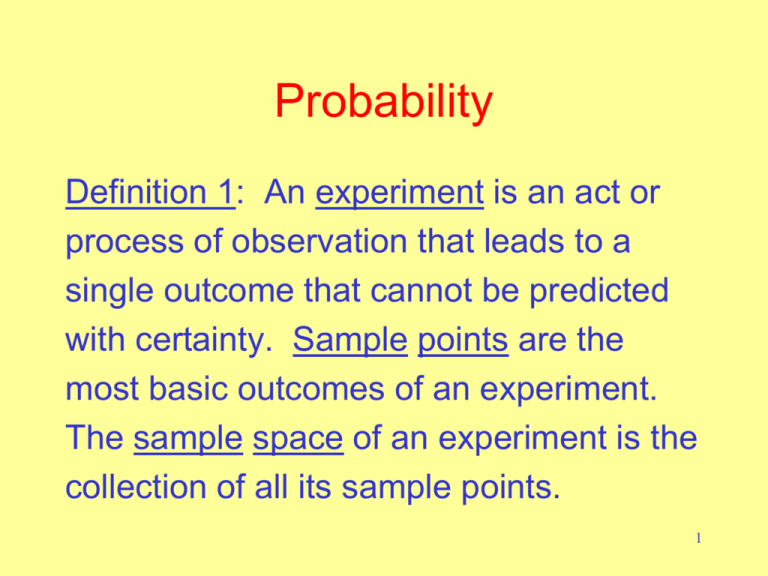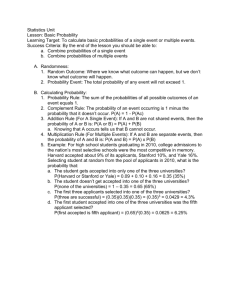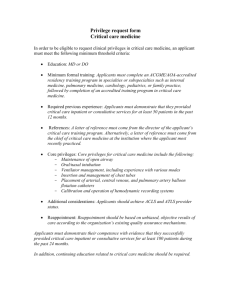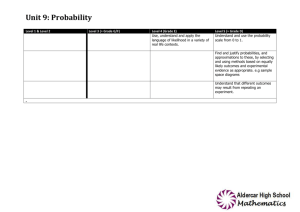Document - Oman College of Management & Technology
advertisement

Probability
Definition 1: An experiment is an act or
process of observation that leads to a
single outcome that cannot be predicted
with certainty. Sample points are the
most basic outcomes of an experiment.
The sample space of an experiment is the
collection of all its sample points.
1
Probability
Sometimes we use a Venn Diagram to
portray a sample space.
2
Probability
Example 1: We can depict the sample
space of basic outcomes when rolling a
single die as follows:
.1
.
2
.
3
.
4
.
5
.
6
3
Probability
We assign probabilities to the sample
points of a sample space according to the
following two rules.
1. All sample point probabilities must lie
between 0 and 1.
2. The probabilities of all the sample
points within a sample space must add to 1.
4
Probability
Roughly speaking, the probability that we
give to a sample point is the proportion of
the times it would occur as the outcome in
a very long series of repetitions of the
experiment associated with the sample
space.
5
Probability
Example 2: If we roll a single fair die many
times each of the six possibilities will occur
approximately 1/6 of the time so we associate a
probability of 1/6 with each sample point. If,
however, a Las Vegas gangster built a loaded
die the sample points of the experiment of
rolling it might have probabilities:
1: .1 2: .1
3: .1
4: .2 5: .2 6: .3
6
Probability
Definition 2: An event is a specific
collection of sample points. The
probability of an event A, p(A), is
calculated by summing the probabilities of
the sample points in the sample space
that fall within A.
7
Probability
Steps for calculating the probability of an event:
1. Define the experiment.
2. List the sample points.
3. Assign probabilities to the sample points.
4. Determine the collection of sample points
contained in the event of interest.
5. Sum the sample point probabilities to get
the event probability.
8
Probability
Example 3: Consider again the
experiment of rolling a die once. Let
the event A be getting a number greater
than 4. What is the probability of A?
Solution. Consider the Venn Diagram
9
Probability
A
.1
.1 .
.
2 . 3 .. 4
2
3
.A
4
.
5 .5.. 6 .6 .
5
6
10
Probability
So for the fair die, p(A) = p(5) + p(6) =
(1/6) + (1/6) = 1/3.
For the loaded die, p(A) = p(5) + p(6) =
.2 + .3 = .5 = ½.
11
Probability
One way we assign probabilities to events
is using the idea of sample points that all
have equal probabilities when it seems to
apply, as for example in the case where
the experiment is to select a sample point
at random.
12
Probability
Example 4: According to USA today
(Sept. 19, 2000), there are 650 members
of the International Nanny Association
(INA). Of these, only three are men. Find
the probability that a randomly selected
member of the INA is a man.
13
Probability
Solution. We can think of 650 sample points in
the sample space. If one is drawn at random
each of the 650 is equally likely to be chosen so
each has probability 1/650. A is the event that
a man is chosen. Since there are three sample
points in A, p(A) = (1/650) + (1/650) + (1/650) =
3/650 .0046.
14
Probability
In the previous example the sample
space had a large number of sample
points - 650. As long as all outcomes are
equally likely we can often conceptualize
a new sample space with a smaller
number of sample points.
15
Probability
Example 5: Two species of rhinoceros native
to Africa are black rhinos and white rhinos. The
International Rhino Federation estimates that
the African rhinoceros population consists of
2,600 white rhinos and 8,400 black rhinos.
Suppose one rhino is selected at random from
the African rhino population and its species
(black or white) is observed.
16
Probability
(a) List the sample points for this experiment
(b) Assign probabilities to the sample points
based on the estimates made by the
International Rhino association.
Solution. (a) two sample points: black rhino,
white rhino
(b) Total number of rhinos is 2,600 + 8,400 =
11,000. Therefore p(white rhino) =
2,600/11,000 .21 and p(black rhino) =
8,400/11,000 .79.
17
Probability
We have two ways to compound events from
other events.
Definition 3: The union of two events A and B
is the event that occurs if either A or B or both
occur on a single performance of the
experiment. We denote the union of events A
and B by the symbol A B. A B consists of
all the sample points that belong to A or B or
both.
18
Probability
Union of A and B
A
A
B
B
19
Probability
Definition 4: The intersection of two events A
and B is the event that occurs if both A and B
occur on a single performance of the
experiment. We write A B for the intersection
of A and B. A B consists of all the sample
points that belong to both A and B.
A B is the overlap of A and B in the Venn
Diagram. (See board.)
20
Probability
Definition 5: The complement of an
event A is the event that A does not occur
– that is, the event consisting of all
sample points in the sample space that
are not in event A. We dente the
complement of A by Ac. (See board.)
21
Probability
Definition 6: Events A and B are
mutually exclusive if A B contains no
sample points, that is, if A and B have no
sample points in common.
22
Probability
So far we have developed an algebra of
events – i.e., ways of compounding them,
compliments, a name for a special case of
the intersection of two events, etc. Now
we need some rules for assigning
probabilities to some of the events of our
algebra.
23
Probability
Some Probability Rules
1. p(A) + p(Ac) = 1
2. p(A B) = p(A) + p(B) – p(A B)
3. If A and B are mutually exclusive then
p(A B) = 0
From 2 and 3 it follows that If A and B are
mutually exclusive then
4. p(A B) = p(A) + p(B)
24
Probability
Example 6: Consider the Venn
Diagram on the board where there are
seven sample points E1, E2,. . ., E7 in the
sample space with p(E1) = p(E2) = p(E3) =
p(E7) = 1/5, p(E4) = p(E5) = 1/20, and
p(E6) = 1/10. Find each of the following
probabilities.
25
Probability
(a) p(A)
(c ) p(A B)
(e) p(Ac)
(g) p(A Ac)
(b) p(B)
(d) p(A B)
(f) p(Bc)
(h) p(Ac B)
26
Probability
Solution.
(a) A = {E1, E2, E3, E5, E6} so p(A) = p(E1)
+ p(E2) + p(E3) + p(E5) + p(E6) = (1/5) +
(1/5) + (1/5) + (1/20) + (1/10) = ¾ = .75
(b) B = {E2, E3, E4, E7} so p(B) = p(E2) +
p(E3) + p(E4) + p(E7) = (1/5) + (1/5) +(1/20) +
(1/5) = 13/20 = .65
27
Probability
(c) A B = {E1, E2, E3, E4, E5, E6, E7} so
p(A B ) = p(E1) + p(E2) + p(E3) + p(E4) +
p(E5) + p(E6) + p(E7) = (1/5) + (1/5) +
(1/5) + (1/20) + (1/20) + (1/10) + (1/5) = 1
(d) A B = {E2, E3} so p(A B) = p(E2) +
p(E3) = (1/5) + (1/5) = 2/5 = .4
28
Probability
(d) Ac = {E4, E7} so p(Ac) = p(E4) + p(E7) =
(1/20 + (1/5) = ¼ = .25
(e) Bc = {E1, E5, E6} so p(Bc) = p(E1) +
p(E5) + p(E6) = (1/5) + (1/20) +(1/10) +
= 7/20 = .35
29
Probability
(f) A Ac = {E1, E2, E3, E4, E5, E6, E7} so
p(A Ac ) = p(E1) + p(E2) + p(E3) + p(E4)
+ p(E5) + p(E6) + p(E7) = (1/5) + (1/5) +
(1/5) + (1/20) + (1/20) + (1/10) + (1/5) = 1
(g) Ac B = {E4, E7} so p(Ac B) = p(E4) +
p(E7) = (1/20) + (1/5) = 1/4 = .25
30
Probability
Example 7: In professional sports, “stacking”
is a term used to describe the practice of
African-American players being excluded from
certain positions because of race. To illustrate
the stacking phenomenon, the “Sociology of
Sport Journal” (Vol. 14, 1997) presented the
table shown below. The table summarizes the
race and positions of 368 NBA players in
1993.Suppose an NBA player is selected at
31
random from that year’s player pool.
Probability
Position
Guard Forward Center
White
26
30
28
Black 128
122
34
Totals
84
284
Totals
368
154
152
62
32
Probability
(a) What is the probability that the player is
white?
(b) What is the probability that the player is a
center?
(c) What is the probability that the player is
African-American and plays guard?
(d) What is the probability that the player is not
a guard?
(e) What is the probability that the player is
33
white or a center?
Probability
Solution. W = White, C = center, G =
Guard, A = African-American
(a) p(W) = 84/368 = .228
(b) p(C) = 62/368 =.168
(c) p(AG) = 128/368 = .348
(d) p(Gc) = 1 – p(G) = 1 – (154/368) = 1 –
.418 = .582
34
Probability
(e) p(WC) = p(W) + p(C) – p(WC) =
(84/368) +(62/368) – (28/368) =
.228 + .168 - .76 = .320
35
Probability
Recall that we called the proportion of
times an event comes up in a long series
of repetitions of the experiment the
probability of the event. More precisely,
this is the unconditional probability of the
event.
36
Probability
Definition 7: To find the conditional
probability that event A occurs given that
event B occurs, divide the probability that
both A and B occur by the probability that
B occurs, that is, p(A|B) = p(AB)/p(B)
(assuming that p(B) 0)
37
Probability
Example 8: Among the 30 applicants for
a position at a credit union, some are
married and some are not, some have
had experience in banking and some
have not, with the exact breakdown being
38
Probability
Married
Some experience
No experience
Single
6
3
12
9
39
Probability
If the branch manager randomly chooses
the applicant to be interviewed first, M denotes
the event that the first applicant to be
interviewed is married, and E denotes the event
that the first applicant to be interviewed has had
some experience in banking, express in words
and also evaluate the following probabilities:
40
Probability
(a) P(M)
(b) P(Ec)
(c) P(M E)
(d) P(Mc Ec)
(e) P(M|E)
41
Probability
M
Mc
E
6 (M E)
3 (Mc E)
Ec
12 (M Ec)
9 (Mc Ec)
42
Probability
First, there are a total of (6 + 3 + 12 + 9) =
30 applicants.
(a) p(M) is the probability an applicant is
married = (#married applicants)/(total
number of applicants) = (6 +12)/30 = .6
43
Probability
(b) p(Ec) is the probability an applicant
has no experience = (#applicants with no
experience)/(total # applicants) =
(12 + 9)/30 = .7
44
Probability
(c) p(M E) is the probability an applicant
is married and experienced =
(# of applicants who are married and
experienced)/(total # applicants) = 6/30 =
.2
45
Probability
(d) P(Mc Ec) is the probability an
applicant is not married and not
experienced = (# applicants who are not
married and not experienced)/(total # of
applicants) = 9/30 = .3
46
Probability
(e) By our definition of conditional
probability we get P(M|E) = P(M E)/P(E)
= .2/.3 = 2/3.
47
Probability
But we can also reason directly from the original
sample space. Once we know that an applicant
is experienced, we no longer need to look at the
whole sample space. We need only consider
the experienced applicants, i.e., the first row of
the table. The probability that an experienced
applicant is married is (the # of applicants who
are married and experienced)/(the # of
applicants who are experienced) = 6/9 = 2/3.
48
Probability
Recall that the conditional probability that
event B occurs given that event A occurs
is p(B|A) = p(AB)/p(A). That implies
that p(AB) = p(A) p(B|A). This will be
true for all events A and B.
49
Probability
Definition 8: Events A and B are
independent events if the occurrence of B
does not alter the probability that A has
occurred; that is p(A|B) = p(A). When
events A and B are independent, it is also
true that p(B|A) = p(B). Events that are
not independent are said to be dependent.
50
Probability
Recall that p(AB) = p(A) p(B|A). This is
true for all events A and B. In the special
case when A and B are independent so
that p(B|A) = p(B), we get p(AB) = p(A) p(B).
We can also show that p(AB) = p(A) p(B)
implies that A and B are independent. So A and
B are independent if and only if p(AB) = p(A)
p(B).
51
Probability
Example 9: An experiment results in
one of the five sample points with the
following probabilities: p(E1) = .22, p(E2) =
.31, p(E3) = .15, p(E4) = .22, p(E5) = .1.
The following events have been defined:
A = {E1, E3}; B = {E2, E3, E4}; C = {E1, E5}
52
Probability
Find each of the following probabilities.
(a) p(A)
(g) Consider each pair of
(b) p(B)
events A and B, A
(c) p(AB)
and C, and B and C.
(d) p(A|B)
Are any of the pairs of
(e) p(BC)
events independent?
(f) p(C|B)
Why?
53
Probability
(a) p(A) = p(E1) + p(E3) = .22 + .15 = .37
(b) p(B) = p(E2) + p(E3) + p(E4) = .31 + .15
+ .22 = .68
(c) p(AB) = p(E3) = .15
(d) p(A|B) = p(AB)/p(B) = .15/.68 = .221
(e) p(BC) = p() = 0
(f) p(C|B) = p(BC)/p(B) = 0/.68 = 0
54
Probability
(g) p(AB) = .15 .2516 = (.37)(.68) =
p(A)p(B) so A and B are not independent
p(BC) = 0 .2176 = (.68)(.32) =
p(B)p(C) so B and C are not independent
p(AC) = .22 .1184 = (.37)(.32) =
p(A)p(C) so A and C are not independent
55
Probability
Notice that from the last problem we learn
that A and B mutually exclusive is not the
same thing as A and B independent.
That is, A and B mutually exclusive
means AB = so p(AB) = p() = 0
while A and B independent means
p(AB) = p(A)p(B).
56
Probability
Definition 9: If n elements are selected
from a population in such a way that
every set of n elements in the population
has an equal probability of being selected,
the n elements are said to be a random
sample.
57
Probability
If n is a positive integer, by n! we mean
the product of n and each positive integer
lower than n down as far as 1. That is, n!
= n.(n-1).(n – 2) . . .3 . 2.1. Also, we define
0! = 1.
58
Probability
Example 10:
6! = 6 x 5 x 4 x 3 x 2 x 1 = 720
59
Probability
If a finite population consists of N objects
then it is possible to show that there are
N!/n!(N-n)! different ways to select n
elements from the population of N. We
use the symbol N for N!/n!(N-n)! .
(n)
60
Probability
If there are
choose
there are
N
(n )
N
(n )
different ways to
n objects out of N then
possible samples from
a
population of size N.
If each such sample has the same probability of
being chosen then that probability is 1/
N
(n)
61
Probability
How do we select a random sample of
size n (without replacement) from a
population of size N? If N is a reasonable
size, we could number each of its
elements, put the numbers in a hat, shake
them up, and take out n. Conceptually, at
least, that is what is involved.
62
Probability
In practice a statistician will use a
computer or a random number table
(originally generated by a computer) to
select the sample.
63
Probability
How does one use a random number
table to select n objects from N?
1. First, number the N objects from 1 to
N.
2. Second, choose at random a row and
column in the random number table to
start at.
3. Count the digits in N.
64
Probability
After that there are a number of equally
good ways to proceed. I will illustrate
some of them in class but you need to
have a random number table (pp. 882-4
of our text) with you.
65







